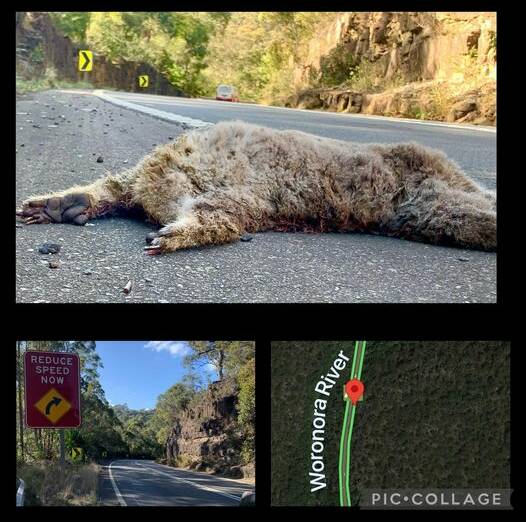Three koalas have been killed on Heathcote Road in the last two months and seven since October last year, local environmental groups say.
Create a free account to read this article
$0/
(min cost $0)
or signup to continue reading
The advocates are calling for the state government to act with more urgency and that a Transport for NSW report on mitigation options is overdue.
Transport for NSW denies the report is delayed and will be released later this year.
The report is being prepared by an environmental consultant, who met with government and council officials and various stakeholder groups on sites along Heathcote Road in March and April this year where possible solutions were discussed.
Sutherland Shire Environment Centre spokeswoman Catherine Reynolds said the need for urgency was illustrated by the deaths of three more koalas along Heathcote Road in less than two months, the latest one near Woronora Bridge on Tuesday this week.

"Sutherland Shire Councillors passed a motion in October last year calling for the state government and Transport NSW to provide infrastructure along Heathcote Road to protect koalas and other native animals," Dr Reynolds said.
"They also called for lights to be installed warning motorists of areas where koalas are most frequently struck by cars."
"Seven koalas have been killed on Heathcote Road since Council passed that motion.
"We know wildlife crossings are an option - millions of dollars are being spent at the Northern Beaches for crossings linking Ku-ringai and Garigal National Parks."
Dr Reynolds said the breeding season, between now and November, was when koalas moved most frequently across the landscape and road kills were frequently reported.
The most recent Heathcote Road kills had been in recognised corridors.
Dr Reynolds said the the Department of Planning, Industry and Environment's NSW Koala Strategy team had advised they would advocate for Sutherland Shire koalas, but warned there was limited funding and Transport NSW may have other priorities.
A spokesman for the department said officers advised Sutherland Shire Environment Centre on August 13 a report on wildlife vehicle strike mitigation was being finalised by Transport for NSW.
"The officers advised centre representatives that once the report is finalised, next steps can be considered regarding wildlife vehicle strike mitigation on Heathcote Road," a spokesman said.
"The government is currently preparing a new 2021-26 strategy to help achieve this goal with a record $193.3 million investment announced in the NSW Government budget 2021-22. This is the largest investment in koala conservation by a state government in Australia."
A Transport for NSW spokeswoman said safety was "a significant issue for the koala population around Deadmans Creek", and an environmental consultant was engaged to prepare a study to examine the options for reducing the risk.
The spokeswoman said two site inspections were conducted in March and April this year with Sutherland Shire Council, Department of Planning, Industry and Environment, Department of Defence, Gandangara LALC, NSW National Parks and Wildlife Service, Sandy Point Residents Association, Georges River Environmental Alliance, Sutherland Environment Centre and Transport for NSW, with possible solutions discussed.
"The consultants are finalising the report," she said.
"The report is not delayed and we are working through the issues raised by this proposal.
"These include how much fencing is required, the alignment with Defence fencing (currently being upgraded), safety considerations within the clear zone of the road, location of the fence to the existing slope, and limiting the impact to Deadmans Creek and surrounding native vegetation.
"Transport for NSW will share the final report with stakeholders when available. As previously advised, this will occur later in 2021."
Sharyn Cullis, the vice president of Save Sydney's Koalas and secretary of the Georges River Environmental Alliance, said there had been increased sightings of koalas in Heathcote National Park, along the bushland gorges of the George and Woronora Rivers and tributary creeks and bushy suburban areas.
"They are frequently on the move and have to negotiate 'killer' high speed hazards, like Heathcote and New Illawarra Roads, and the Princes Highway," Dr Cullis said.
"These koalas are genetically the same population, as those koalas around Appin and Campelltown.
They are so very precious, and should be a priority population for government action, because unlike other koalas in NSW they are disease free, are actually breeding and increasing their numbers and thus needing to expand their home ranges.
"They are rather like an 'insurance' population.
"The challenges they face around Campbelltown and Appin are complex and seemingly insurmountable because the Greater Macarthur Growth Plan proposes to deliver more than 40,000 new homesites into what is prime koala habitat.
"To the east though, in the Sutherland Shire, these koalas can continue their push into vast protected lands including the Holsworthy Military Training Area, the Woronora Drinking Water Catchment and the national parks, if the government gives them a chance.
"The priority need is for safe way to negotiate the road threats, with the appropriate strategies like directional fencing that can funnel them safely into underpasses beneath the most dangerous of roads."
Dr Reynolds has asked people to record all koalas they see on the NSW government I Spy Koala app.
Anyone who hits a koala or other animal while driving is asked to stop if it is safe to do so, as the animal may be injured not dead, and call a wildlife rescue organisation.


